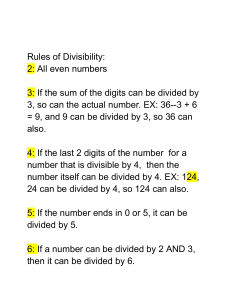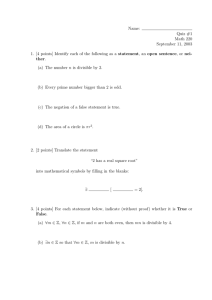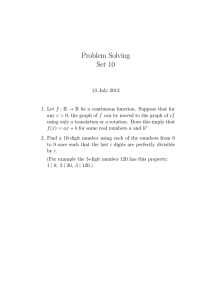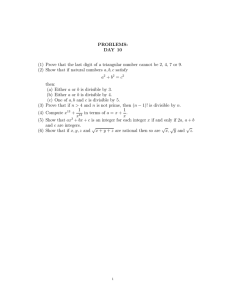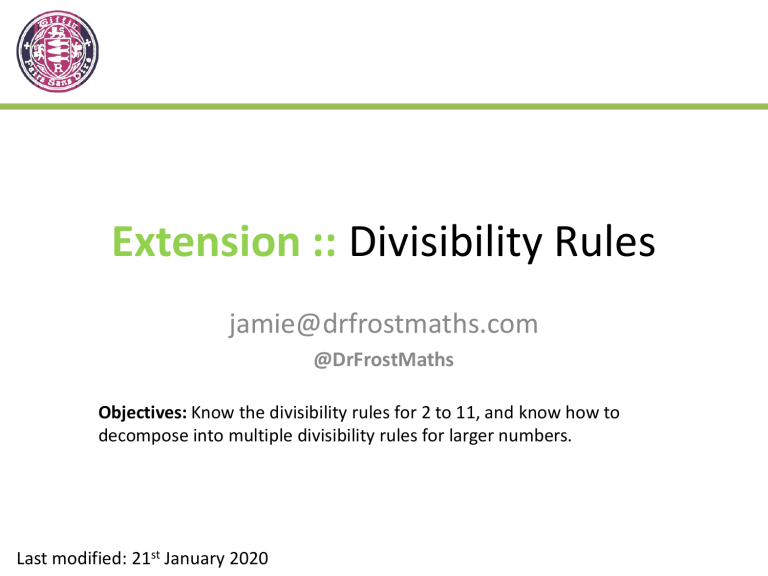
Extension :: Divisibility Rules jamie@drfrostmaths.com @DrFrostMaths Objectives: Know the divisibility rules for 2 to 11, and know how to decompose into multiple divisibility rules for larger numbers. Last modified: 21st January 2020 www.drfrostmaths.com Everything is completely free. Why not register? Register now to interactively practise questions on this topic, including past paper questions and extension questions (including UKMT). Teachers: you can create student accounts (or students can register themselves), to set work, monitor progress and even create worksheets. With questions by: Dashboard with points, trophies, notifications and student progress. Teaching videos with topic tests to check understanding. Questions organised by topic, difficulty and past paper. Divisibility Rules How can we tell if a number is divisible by: ! 2 3 4 5 6 ? Digits add up to multiple of 3. e.g: ? 1692: 1+6+9+2 = 18 Last two digits together are divisible ? by 4. e.g. 143328 Last digit is 0 or 5. ? Number is divisible by 2 and 3 (so use ? tests for 2 and 3). Last digit is even. 7 Double the last digit and subtract it from the remaining number, and see if the result is divisible by 7. e.g: 2464 246 – 8 = 238 23 – 16 = 7. 8 Last three digits divisible by 8. 9 Digits add up to multiple of 9. 10 Last digit 0. 11 When you sum odd-positioned digits and subtract even-positioned digits, the result is divisible by 11. ? ? ? ? ? e.g. 47949: (4 + 9 + 9) – (7 + 4) = 22 – 11 = 11, which is divisible by 11. 12 Number divisible by 3 and by 4. ? Quickfire Divisibility 4 6 7 ? ? ? 726 168 ? ? ? 9196 ? ? ? 252 ? ? ? ? ? ? 1001 ? ? ? 91 216 ? ? ? 87912 ? ? ? 9 11 ? ? ? ? ? ? ? ? ? ? ? ? ? ? ? ? Quickfire Mental Primes Apart from the obvious instant checks (divisibility by 2, 5), we usually only have to mentally check 3, 7 and 11 to have a good ‘guess’ that a number is prime. 3 91 101 234567 131 781 751 221 7 ? 11 Is it prime? No ? ? ? ? ? ? ? ? ? ? No ? Yes ? No! (13? × 17) Yes No Yes Advanced: 13 trick is “Quadruple last digit and add to remaining number. Is result divisible by 13? N For 221, what is the largest prime we would have had to test divisibility until we’d be certain it was prime? Up to 𝟐𝟐𝟏 = 𝟏𝟒. 𝟖𝟕 because all composite numbers have a factor (other than 1) up to the square root. ? Test Your Understanding Easier One: [JMO 1997 A5] Precisely, one of the numbers 234, 2345, 23456, 234567, 2345678, 23456789 is a prime number. Which one must it be? Solution: 23456789? Harder One: [JMC 2012 Q23] Peter wrote a list of all the numbers that could be produced by changing one digit of the number 200. How many of the numbers on Peter’s list are prime? A 0 B 1 C 2 D 3 E 4 Solution: A ? Breaking Down Divisibility Rules Are these statements true or false? If we want to show that a number is divisible by 15, we can show it is divisible by 3 and 5. False True If we want to show that a number is divisible by 24, we can show it is divisible by 6 and 4. False True The problem is that 12 is divisible by 6 and 4, but it is not divisible by 24! We need to pick two numbers which are coprime, i.e. do not share any factors. How can we therefore test if a number is divisible by 24? ! Two numbers 𝑎 and 𝑏 are coprime if 𝑯𝑪𝑭 𝑎, 𝑏 = 1 Quickfire What divisibility rules would we use if we wanted to test divisibility by: 18 45 36 2 and 9 rules 5 and 9 4 and 9 40 5 and 8 ? ? ? ? An ‘easy’ Year 10 Maths Olympiad problem: Find the smallest positive integer which consists only of 0s and 1s, and which is divisible by 12. • Since in must be divisible by 4, the only possibility for the last two digits is 00. • It must have at least?three 1s to be divisible by 3 (as we can’t have zero 0s). • Therefore 11100 is the answer. Exercise 1 (on provided worksheet) [JMC 2011 Q2] How many of the integers 123, 234, 345, 456, 567 are multiples of 3? 4 [ ]1 [ ]2 [ ]3 [ ]4 [ ]5 Answer: 5 2 [ ] 2005 [ ] 2007 [ ] 2009 [ ] 2011 [ ] 2013 ? [JMC 2004 Q2] Which of the following numbers is exactly divisible by 7? [ ] 104 [ ] 106 [ ] 108 [ ] 110 [ ] 112 Answer: 112 ? Solution: 2011 5 ? 3 [JMC 2016 Q11] Which of the following statements is false? [ ] 12 is a multiple of 2 [ ] 123 is a multiple of 3 [ ] 1234 is a multiple of 4 [ ] 12 345 is a multiple of 5 [ ] 123 456 is a multiple of 6 Answer: 1234 ? [JMC 2003 Q13] This is a prime year, since 2003 is a prime number. In the next ten years there is just one prime year. Which is it? [JMC 2005 Q15] There are six different threedigit numbers, each of which contains all the digits 1, 3 and 5. How many of these three-digit numbers are prime? [ ]0 [ ]1 [ ]2 [ ]3 [ ]4 Solution: 0 ? 6 [JMC 1999 Q17] The 8-digit number 1234*678 is a multiple of 11. Which digit is represented by *? Solution: 9 ? Exercise 7 (on provided worksheet) [JMC 2000 Q17] The first and third digits of the five-digit number 𝑑6𝑑41 are the same. If the number is exactly divisible by 9, what is the sum of its five digits? Solution: 9 10 ? 8 [JMC 1997 Q20] A four-digit number was written on a piece of paper. The last two digits were then blotted out (as shown). If the complete number is exactly divisible by three, by four, and by five, what is the sum of the two missing digits? Solution: 4 ? 9 [IMC 1997 Q12] Gill is nine years old this year so she was fascinated to discover that an integer is divisible by 9 precisely when the sum of its digits is also divisible by 9. If the six-digit number “1*3456” is to be a multiple of 9, what must the missing digit be? Solution: 8 ? [JMC 2012 Q23] Peter wrote a list of all the numbers that could be produced by changing one digit of the number 200. How many of the numbers on Peter’s list are prime? [ ]0 [ ]1 [ ]2 [ ]3 [ ]4 Solution: 0 ? 11 [JMC 2015 Q24] A palindromic number is a number that reads the same when the order of its digits is reversed. What is the difference between the largest and smallest five-digit palindromic numbers that are both multiples of 45? Solution: 9090 ? Exercise (on provided worksheet) 12 [JMO 2011 B1] Every digit of a given positive integer is either a 3 or a 4 with each occurring at least once. The integer is divisible by both 3 and 4. What is the smallest such integer? Solution:? 3444 13 [SMC 2012 Q6] What is the sum of the digits of the largest 4-digit palindromic number which is divisible by 15? Palindromic numbers read the same backwards and forwards, e.g. 7227. Solution: 24 ? 14 [JMO 2010 B2 Edited] The eight-digit number “𝑝𝑝𝑝𝑝𝑞𝑞𝑞𝑞”, where 𝑝 and 𝑞 are digits, is a multiple of 45. What are the possible values of the eight-digit number? Solution: 44445555 and 99990000 ? 15 [SMC 2009 Q10] Consider all threedigit numbers formed by using different digits from 0, 1, 2, 3 and 5. How many of these numbers are divisible by 6? Solution: 7 ? Exercise (on provided worksheet) 16 [Cayley 2005 Q4] The five-digit number '𝑎679𝑏', where 𝑎 and 𝑏 are digits, is divisible by 36. Find all possible such five-digit numbers. Solution: 36792 ? and 86796 17 [SMC 2014 Q9] Which of the following is divisible by 9? [ ] 102014 + 5 [ ] 102014 + 6 [ ] 102014 + 7 [ ] 102014 + 8 [ ] 102014 + 9 𝟏𝟎𝟐𝟎𝟏𝟒 + 𝟖 ? 18 [JMO 2017 B6] The 9-digit positive integer 𝑁 with digit pattern 𝐴𝐵𝐶𝐴𝐵𝐶𝐵𝐵𝐵 is divisible by every integer from 1 to 17 inclusive. The digits 𝐴, 𝐵 and 𝐶 are distinct. What are the values of 𝐴, 𝐵 and 𝐶? 𝑨 = 𝟑, 𝑩 = 𝟎, 𝑪 = 𝟔 ? 19 [IMC 2007 Q19] The following sequence continues indefinitely: 27 = 3 × 3 × 3, 207 = 3 × 3 × 23, 2007 = 3 × 3 × 223, 20007 = 3 × 3 × 2223, Which of the following integers is a multiple of 81? [ ] 200 007 [ ] 20 000 007 [ ] 2 000 000 007 [ ] 200 000 000 007 [ ] 20 000 000 000 007 ?
